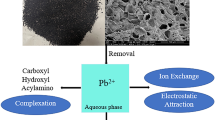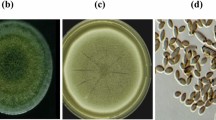Abstract
The use of agricultural wastes as biosorbents is gaining importance in bioremediation of heavy metal-polluted water and soils, due to their effectiveness and low cost. This work assesses the Cd, Pb and Cu adsorption capacity of the raw materials used in the production of substrates for mushroom production (Agaricus bisporus and Pleurotus ostreatus) and the spent mushroom composted (SMC), based on the functional groups of their organic carbon. The raw materials studied included agricultural wastes (wheat straw, wheat and rice poultry litter, grape pomace) and inorganic substances (gypsum and calcareous sand). Organic carbon from wastes and their composting products were characterized by CP-MAS 13C NMR. Langmuir adsorption isotherms of metals were plotted for each raw material, composting step, spent A. bisporus and P. ostreatus substrates and the final SMC. The maximum adsorption capacities of SMC were 40.43, 15.16 and 36.2 mg g−1 for Cd, Pb and Cu, respectively. The composting process modified the adsorption properties of raw materials because of the enhanced adsorption of Cd and Cu and decreased adsorption capacity of Pb. CP-MAS 13C NMR and potentiometric titration were used to identify the functional groups of the organic carbon responsible for the metal adsorption. The content of cellulose was correlated with Pb adsorption (p < 0.001), alkyl and carboxyl carbon with Cd adsorption (p < 0.001), and N-alkyl (p < 0.001) and carboxyl (p < 0.010) groups with Cu adsorption. These results are valuable to develop new biosorbents based on agricultural wastes and demonstrate the high potential of SMC to adsorb heavy metals from polluted environments.



Similar content being viewed by others
References
Abdolali A, Guo WS, Ngo HH et al (2014) Typical lignocellulosic wastes and by-products for biosorption process in water and wastewater treatment: a critical review. Bioresour Technol 160:57–66. doi:10.1016/j.biortech.2013.12.037
Alves-Gurgel LV, Karnitz-Junior O, de Freitas-Gil RP, Gil LF (2008) Adsorption of Cu (II), Cd (II), and Pb (II) from aqueous single metal solutions by cellulose and mercerized cellulose chemically modified with succinic anhydride. Bioresour Technol 99:3077–3083. doi:10.1016/j.biortech.2007.05.072
Ashrafi M, Mohamad S, Yusoff I, Shahul Hamid F (2014) Immobilization of Pb, Cd, and Zn in a contaminated soil using eggshell and banana stem amendments: metal leachability and a sequential extraction study. Environ Sci Pollut Res 22:223–230. doi:10.1007/s11356-014-3299-4
Baker H, Khalili F (2004) Analysis of the removal of lead(II) from aqueous solutions by adsorption onto insolubilized humic acid: temperature and pH dependence. Anal Chim Acta 516:179–186. doi:10.1016/j.aca.2004.03.068
Baker H, Khalili F (2005) A study of complexation thermodynamic of humic acid with cadmium (II) and zinc (II) by Schubert’s ion-exchange method. Anal Chim Acta 542:240–248. doi:10.1016/j.aca.2005.04.008
Benguella B, Benaissa H (2002) Cadmium removal from aqueous solutions by chitin: kinetic and equilibrium studies. Water Res 36:2463–2474. doi:10.1016/S0043-1354(01)00459-6
Bhatnagar A, Sillanpää M (2010) Utilization of agro-industrial and municipal waste materials as potential adsorbents for water treatment—a review. Chem Eng J 157:277–296. doi:10.1016/j.cej.2010.01.007
Chanakya HN, Malayil S, Vijayalakshmi C (2015) Cultivation of Pleurotus spp. on a combination of anaerobically digested plant material and various agro-residues. Energy Sustain Dev 27:84–92. doi:10.1016/j.esd.2015.04.007
Chen GQ, Zeng GM, Tu X et al (2005) A novel biosorbent: characterization of the spent mushroom compost and its application for removal of heavy metals. J Environ Sci 17:756–760
Chuah TG, Jumasiah A, Azni I et al (2005) Rice husk as a potentially low-cost biosorbent for heavy metal and dye removal: an overview. Desalination 175:305–316. doi:10.1016/j.desal.2004.10.014
Clemente R, Pardo T, Madejón P et al (2015) Food byproducts as amendments in trace elements contaminated soils. Food Res Int 73:176–189. doi:10.1016/j.foodres.2015.03.040
Codling EE, Chaney RL, Mulchi CL (2008) Effects of broiler litter management practices on phosphorus, copper, zinc, manganese, and arsenic concentrations in maryland coastal plain soils. Commun Soil Sci Plant Anal 39:1193–1205. doi:10.1080/00103620801925901
de Quadros Melo D, de Oliveira Sousa Neto V, de Freitas Barros FC et al (2016) Chemical modifications of lignocellulosic materials and their application for removal of cations and anions from aqueous solutions. J Appl Polym Sci 133:43286. doi:10.1002/app.43286
Durrant AJ, Wood DA, Cain RB (1991) Lignocellulose biodegradation by Agaricus bisporus during solid substrate fermentation. J Gen Microbiol 137:751–755
Esposito A, Pagnanelli F, Lodi A et al (2001) Biosorption of heavy metals by Sphaerotilus natans: an equilibrium study at different pH and biomass concentrations. Hydrometallurgy 60:129–141. doi:10.1016/S0304-386X(00)00195-X
Fernandes Â, Barros L, Martins A et al (2014) Nutritional characterisation of Pleurotus ostreatus (Jacq. ex Fr.) P. Kumm. produced using paper scraps as substrate. Food Chem 169:396–400. doi:10.1016/j.foodchem.2014.08.027
García-Delgado C, Yunta F, Eymar E (2015) Bioremediation of multi-polluted soil by spent mushroom (Agaricus bisporus) substrate: polycyclic aromatic hydrocarbons degradation and Pb availability. J Hazard Mater 300:281–288. doi:10.1016/j.jhazmat.2015.07.008
Garrido F, Illera V, García-González MT (2005) Effect of the addition of gypsum- and lime-rich industrial by-products on Cd, Cu and Pb availability and leachability in metal-spiked acid soils. Appl Geochem 20:397–408. doi:10.1016/j.apgeochem.2004.08.001
Gąsecka M, Mleczek M, Siwulski M et al (2015) The effect of selenium on phenolics and flavonoids in selected edible white rot fungi. LWT Food Sci Technol 63:726–731. doi:10.1016/j.lwt.2015.03.046
Hanč A, Tlustoš P, Száková J et al (2008) Direct and subsequent effect of compost and poultry manure on the bioavailability of cadmium and copper and their uptake by oat biomass. Plant Soil Environ 54:271–278
Herrero-Hernández E, Andrades MS, Marín-Benito JM et al (2011) Field-scale dissipation of tebuconazole in a vineyard soil amended with spent mushroom substrate and its potential environmental impact. Ecotoxicol Environ Saf 74:1480–1488. doi:10.1016/j.ecoenv.2011.04.023
Herrero-Hernández E, Andrades MS, Rodríguez-Cruz MS et al (2012) Long-term variability of metals from fungicides applied in amended young vineyard fields of La Rioja (Spain). Environ Monit Assess 184:3359–3371. doi:10.1007/s10661-011-2194-4
Hokkanen S, Bhatnagar A, Sillanpää M (2016) A review on modification methods to cellulose-based adsorbents to improve adsorption capacity. Water Res 91:156–173. doi:10.1016/j.watres.2016.01.008
Illera V, Garrido F, Serrano S, García-González MT (2004) Immobilization of the heavy metals Cd, Cu and Pb in an acid soil amended with gypsum- and lime-rich industrial by-products. Eur J Soil Sci 55:135–145. doi:10.1046/j.1365-2389.2003.00583.x
Jain M, Garg V, Kadirvelu K, Sillanpää M (2016) Adsorption of heavy metals from multi-metal aqueous solution by sunflower plant biomass-based carbons. Int J Environ Sci Technol 13:493–500. doi:10.1007/s13762-015-0855-5
Janyasuthiwong S, Phiri SM, Kijjanapanich P et al (2015) Copper, lead and zinc removal from metal-contaminated wastewater by adsorption onto agricultural wastes. Environ Technol 36:3071–3083. doi:10.1080/09593330.2015.1053537
Kardam A, Raj KR, Srivastava S, Srivastava MM (2013) Nanocellulose fibers for biosorption of cadmium, nickel, and lead ions from aqueous solution. Clean Technol Environ Policy. doi:10.1007/s10098-013-0634-2
Khan FI, Husain T, Hejazi R (2004) An overview and analysis of site remediation technologies. J Environ Manag 71:95–122. doi:10.1016/j.jenvman.2004.02.003
Khandanlou R, Ahmad MB, Fard Masoumi HR et al (2015) Rapid adsorption of copper(II) and lead(II) by rice straw/Fe3O4 nanocomposite: optimization, equilibrium isotherms, and adsorption kinetics study. PLoS ONE 10:1–19. doi:10.1371/journal.pone.0120264
Lee SS, Lim JE, Abd El-Azeem SAM et al (2013) Heavy metal immobilization in soil near abandoned mines using eggshell waste and rapeseed residue. Environ Sci Pollut Res 20:1719–1726. doi:10.1007/s11356-012-1104-9
Lindsay WL (1979) Chemical equilibria in soils. Wiley, New York
Liu C, Pujol D, Olivella MÀ, De Torre F (2015) The role of exhausted coffee compounds on metal ions sorption. Water Air Soil Pollut 226:1–10. doi:10.1007/s11270-015-2568-2
McGrath SP, Zhao FJ (2003) Phytoextraction of metals and metalloids from contaminated soils. Curr Opin Biotechnol 14:277–282. doi:10.1016/S0958-1669(03)00060-0
Medina J, Monreal C, Barea JM et al (2015) Crop residue stabilization and application to agricultural and degraded soils: a review. Waste Manag 42:41–54. doi:10.1016/j.wasman.2015.04.002
Nachtigall GR, Nogueirol RC, Alleoni LRF, Cambri MA (2007) Copper concentration of vineyard soils as a function of pH variation and addition of poultry litter. Braz Arch Biol Technol 50:941–948. doi:10.1590/S1516-89132007000700005
Negro C, Tommasi L, Miceli A (2003) Phenolic compounds and antioxidant activity from red grape marc extracts. Bioresour Technol 87:41–44. doi:10.1016/S0960-8524(02)00202-X
Pardo-Giménez A, Pardo-González JE (2008) Evaluation of casing materials made from spent mushroom substrate and coconut fibre pith for use in production of Agaricus bisporus (Lange) Imbach. Span J Agric Res 6:683–690
Paredes C, Medina E, Moral R et al (2009) Characterization of the different organic matter fractions of spent mushroom substrate. Commun Soil Sci Plant Anal 40:150–161. doi:10.1080/00103620802625575
Pérez-Esteban J, Escolástico C, Masaguer A et al (2014) Soluble organic carbon and pH of organic amendments affect metal mobility and chemical speciation in mine soils. Chemosphere 103:164–171. doi:10.1016/j.chemosphere.2013.11.055
Sari A, Tuzen M (2008) Biosorption of Pb(II) and Cd(II) from aqueous solution using green alga (Ulva lactuca) biomass. J Hazard Mater 152:302–308. doi:10.1016/j.jhazmat.2007.06.097
Shin EW, Karthikeyan KG, Tshabalala MA (2007) Adsorption mechanism of cadmium on juniper bark and wood. Bioresour Technol 98:588–594. doi:10.1016/j.biortech.2006.02.024
Srivastava S, Agrawal SB, Mondal MK (2015) A review on progress of heavy metal removal using adsorbents of microbial and plant origin. Environ Sci Pollut Res 22:15386–15415. doi:10.1007/s11356-015-5278-9
Stevenson FJ (1994) Humus chemistry. Wiley, New York
Sud D, Mahajan G, Kaur MP (2008) Agricultural waste material as potential adsorbent for sequestering heavy metal ions from aqueous solutions—a review. Bioresour Technol 99:6017–6027. doi:10.1016/j.biortech.2007.11.064
Tapia Y, Cala V, Eymar E et al (2010) Chemical characterization and evaluation of composts as organic amendments for immobilizing cadmium. Bioresour Technol 101:5437–5443. doi:10.1016/j.biortech.2010.02.034
Town RM, Powell HKJ (1993) Ion-selective electrode potentiometric studies on the complexation of copper(II) by soil-derived humic and fulvic acids. Anal Chim Acta 279:221–233
Whitney KD, Arnott HJ (1987) Calcium oxalate crystal morphology and development in Agaricus bisporus. Mycologia 79:180. doi:10.2307/3807650
Wong KK, Lee CK, Low KS, Haron MJ (2003) Removal of Cu and Pb by tartaric acid modified rice husk from aqueous solutions. Chemosphere 50:23–28
Yun Y, Park D, Park JM, Volesky B (2001) Biosorption of trivalent chromium on the brown seaweed biomass. Environ Sci Technol 35:4353–4358. doi:10.1021/es010866k
Zhou D, Zhang L, Guo S (2005) Mechanisms of lead biosorption on cellulose/chitin beads. Water Res 39:3755–3762. doi:10.1016/j.watres.2005.06.033
Acknowledgments
This work has been economically supported by Ministry of Economy and Competitiveness of Spain (CTM2013-47874-C2-2-R).
Author information
Authors and Affiliations
Corresponding author
Rights and permissions
About this article
Cite this article
Frutos, I., García-Delgado, C., Gárate, A. et al. Biosorption of heavy metals by organic carbon from spent mushroom substrates and their raw materials. Int. J. Environ. Sci. Technol. 13, 2713–2720 (2016). https://doi.org/10.1007/s13762-016-1100-6
Received:
Revised:
Accepted:
Published:
Issue Date:
DOI: https://doi.org/10.1007/s13762-016-1100-6




